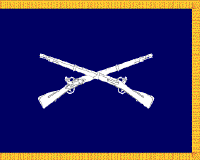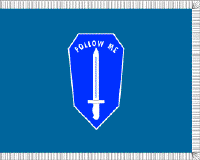| Revision as of 20:35, 19 September 2006 edit150.226.95.18 (talk) →Units Present at Fort Benning← Previous edit | Revision as of 20:35, 19 September 2006 edit undo150.226.95.18 (talk) →See alsoNext edit → | ||
| Line 155: | Line 155: | ||
| ==See also== | ==See also== | ||
| * ] | * ] | ||
| * ] | |||
| ] | ] | ||
Revision as of 20:35, 19 September 2006
| US Army Infantry Center & Fort Benning & the US Army Infantry School | |
|---|---|
  US Army Infantry Center Flag and US Army Infantry School Flag US Army Infantry Center Flag and US Army Infantry School Flag | |
| Country | USA |
| Allegiance | Federal |
| Branch | Infantry |
| Type | Garrison and School |
| Colors | Blue and White |
Fort Benning is a United States Army base, located southwest of Columbus, Georgia in Muscogee County, Chattahoochee County and Russell Counties, Georgia. It is part of the Columbus, Georgia-Alabama Metropolitan Statistical Area.
Fort Benning is a self-sustaining military community supporting in excess of 100,000 military, family members, reserve component soldiers, retirees, and civilian employees on a daily basis. It is a premier power projection platform, and possesses the capability to deploy combat-ready forces by air, rail, and highway. Fort Benning is the home of the United States Army Infantry School, the Western Hemisphere Institute for Security Cooperation, Special Operations Command's only Ranger Regiment, the 75th Ranger Regiment, the 3rd Brigade, 3rd Infantry Division (Mechanized), 36th Engineer Group (Construction), the 14th Combat Support Hospital, and a myriad of additional tenant units.
History
Fort Benning is named for BG Henry L. Benning, a general of the Confederate States of America Army and a native of Columbus. It was established in October 1918 as Camp Benning, and did not receive permanent quarters and status until World War II. The base covers 182,000 acres (737 km²). During World War II, Fort Benning included 197,159 acres (797.87 km²), and had billeting space for 3,970 officers and 94,873 enlisted persons. The Chattahoochee River runs through Fort Benning. Due to the deep green/black color of the water, it is known to the soldiers of the 586th Engineer Co. (Float Bridge) as the 'Chattanasty'.
During World War Two (WWII) Fort Benning became home to the 555th Parachute Infantry Company, known as the Triple Nickel. Their training began in December 1943. This represented an important milestone for black Americans. The Triple Nickel became a respected nickname for the infantry and represents the proud legacy of the first black airborne unit.
The Airborne School on Main Post has three 249-foot (76 m) drop towers called "Control Desent Towers" for training paratroopers, familiar Fort Benning landmarks, they were built after soldiers trained in New Jersey on a similar tower designed by the company which built parachute towers for the 1939 World's Fair in New York. Only three towers stand today, the fourth tower was toppled by a tornado on March 14th, 1954.
Convicted Vietnam War war criminal William Calley spent 3 1/2 years under house arrest at Fort Benning.
Mission
Fort Benning's first mission was to provide Basic Training for units participating in World War II. With the end of that war, Benning was closed until the Army could find a use for it. The first Tenant Unit to arrive was the Infantry School, which has been there ever since. The Civilian Conservation Corps completed the wooden permanent buildings in the 1930s, and Fort Benning expanded from that point forward.
The 555th Parachute Infantry Company was trained at Fort Benning and deployed only within the continental United States during WWII. The specialized duties of the Triple Nickel were primarily firefighting duties as parachute smoke jumpers. The 555th was secretly deployed to the Pacific Northwest in the United States in responce to an anticipated threat. There was concern that forest fires were being deliberately set by the Japanese military using incendiary balloons as an attempt to produce terror among the citizens. The 555th successfully completed over 1,000 missions as smoke jumpers and thwarted the enemy's attempts to spread terror within the United States.
Fort Benning is where the US 2nd Armored Division was formed.
The post has a large basic training facility for infantry. It is home to the Infantry Training Brigade of the United States Army as well being the Army's airborne (parachuting) training center. Further, it is home to a Basic Combat Training Brigade (BCTB) on Sand Hill. This is distinguished from the Infantry Training Brigade (ITB) in that ITB includes both basic training and infantry Advanced Individual Training (AIT). ITB training therefore lasts 14 weeks while BCT is 9 weeks. BCTB is used to train non-infantry personnel, who go on to AIT at other duty stations.
Post organization

There are four main cantonment areas on Fort Benning. They are the Main Post area, Kelley Hill, Sand Hill and Harmony Church.
Main Post houses various garrison and smaller FORSCOM units of Fort Benning such as 36th Engineer Group, 988th Military Police Company, the 43rd Engineer Battalion, and the 29th Infantry Regiment, as well as a number of TRADOC-related tenants, e.g., Officer Candidate School, Primary Leadership Development Course and Airborne School.
Kelley Hill houses the 3rd Brigade of the 3rd Infantry Division (Mechanized).
Sand Hill is the primary location of the Infantry Training Brigade and Basic Combat Training Brigade.
Harmony Church area houses the Sniper and Ranger schools, and the 1st Battalion of the 29th Infantry Regiment (training support for Bradley Fighting Vehicles and Strykers) at Building 5500. Victoria Pond, where the amphibious training for the Bradleys take place is out there. Also in this area, about 1 mile (2 km) from Red Diamond Road is a Civil War era cemetery in a large meadow. The graveyard is marked in the C C 2 area on the Fort Benning tactical military map as CEMETERY 2.
Fryar Drop Zone, the drop zone that airborne students land on, is in the Alabama portion of Fort Benning.
Fort Benning is also home to:
- The Western Hemisphere Institute for Security Cooperation (WHINSEC), formerly known as School of the Americas
- The US Army Pathfinder training school
- US Army Officer Candidate School
- US Army Rangers School
- 75th Ranger Regiment Headquarters
- 3rd Ranger Battalion
- The Infantry Officer's Basic Course (IOBC)
As of August 2005, Major General Walter Wojdakowski is the current post commander.
Because of all of the essential programs it is home to, Fort Benning is considered extremely unlikely to be impacted by the Base Realignment and Closing Commission (BRAC), unlike many of Georgia's other military facilities, which are at risk.
Fort Benning is the main set of the popular and free online first-person shooter, America's Army.
Post Commanders have included General John 'Black Jack' Pershing and General Omar Bradley, for whom the Bradley Fighting Vehicle was named.
Fort Benning in the movies, books, and legend
In the movie "We Were Soldiers", Fort Benning is used as the background for the scenes where the housing area is, as well as Doughboy Stadium.
In the movie Tank, James Garner was inside a bar on an Army post and a neon sign reading END OF THE HALL was visible. That footage was shot inside the Fort Benning Non-Commissioned Officer Club.
In one of W.E.B. Griffin's books in the Brotherhood of War series a chewing out at the Airborne School was described as a high school drop-out screaming into your face that "He didn't know what kinda chicken-shit outfit you came here from, but you better get your act together real quick, or I'll ship you outta here so fast your asshole won't catch up with you for 2 weeks!"
A story circulates in the Fort Benning area that in the past there had been a situation where Phenix City, Alabama, a town across the Chattahoochee River, had some Fort Benning troops in jail and wouldn't give them back. The story goes that the (unnamed) Commanding General assembled 8000 troops at the bridge and threatened to send them in to rescue the men if they weren't released. An alternate version told was that the General pulled several tanks up on the banks of the river and threatened to open fire. The version with tanks often is cited as having been General George S. Patton when he was at Fort Benning. However, a military historian has stated that the story was partially true in the sense that a general once threatened to roll tanks into Phenix City but that the general in question was not Patton.
In Scent of a Woman, Al Pacino's character is questioned by his nephew at which US Army fort he lost his vision. "Fort Bragg?" questions the nephew. "No, Fort Benning," replies Pacino's character, Lt. Col. Frank Slade.
Several scenes from the movie "the Green Berets" were filmed at Fort Benning and in downtown Columbus, Ga. Including the attack on the simulated special forces A camp, the helicopter assault on the bridging of the river, and the house where the SF team kidnapped the NVA general was located in downtown Columbus, Ga. The movie theater in the Sand Hill area of Ft. Benning is in the background on one of the helicopter landing scenes in the beginning of the movie.
A few characters in Tom Clancy's bestselling novel Rainbow Six were trained/stationed in Fort Benning.
During Season Two of 24 a Colonel Ron Samuels headed a Special Ops team tracking a bomb. This team was said to be based at Fort Benning. Jack Bauer was also said to have been approached by Samuels whilst being in the military.
General Information
Command Group
- Commanding General/Commandant: Major General Walter Wojdakowski
- Deputy Commandant: Colonel Michael Linnington
- Command Sergeant Major: Command Sergeant Major Lonny Wright
Units Present at Fort Benning
- Unit, Command
- Ranger Training Brigade, TRADOC
- 4th Ranger Training Battalion, TRADOC
- Infantry Training Brigade, TRADOC
- Basic Combat Training Brigade, TRADOC
- U.S. Army Garrison, Installation Management Agency (IMA)
- 3rd Brigade Combat Team, 3rd Infantry Division
- D Troop, 10th Cavarly, 3rd Brigade Combat Team
- 1-15 Infantry, 3rd Brigade Combat Team
- 2nd Battalion, 69th Armor Regiment, 3rd Brigade Combat Team
- 317 Engineer, 3rd Brigade Combat Team
- 1-10 Field Artillery, 3rd Brigade Combat Team
- 14th Field Combat Support Hospital, 44th MEDCOM
- Martin Army Community Hospital, AMEDD
- DENTAC, USA DENTAC
- US.Army Marksmanship Unit, USAAC
- 17th Air Support Operations Squadron, USAF
